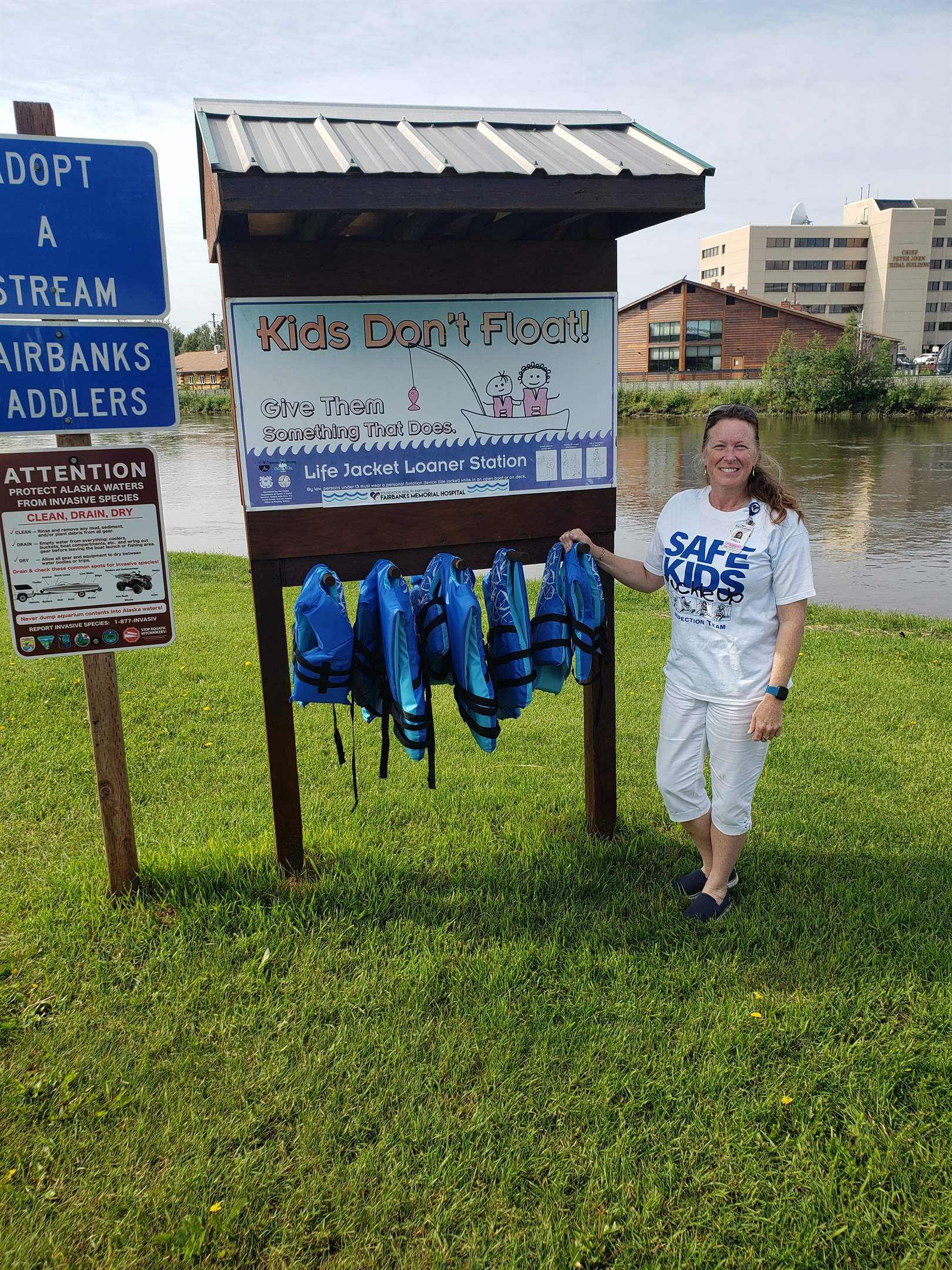Safe Kids Fairbanks aims to protect children from preventable injuries and death in our community, and provide injury prevention education for water safety.
Saving lives while in or around water is all about being prepared. With three quarters of Alaska’s population living on waterways, we know and understand that Alaskans work and play around the water, and our long summer days are the busiest time of year for water-related activities.

Kids Don't Float
 Look for the Kid’s Don’t Float life jacket loaner boards, where you can borrow a life jacket while in and around water.
Look for the Kid’s Don’t Float life jacket loaner boards, where you can borrow a life jacket while in and around water.Whether boating or being on the shore by the lake, ponds or rivers, we need to be reminded that water temperatures remain cold during the summer months. These cold-water temperatures are dangerous to the human body.
When planning water activities with your friends and families:
- Make wearing life jackets the first thing on your checklist.
- Make sure everyone in the boat has a life jacket and double check that they fit properly.
- Do not use torn or broken life jackets.
- Review water safety with everyone in your group.
Two-thirds of Alaska's drowning deaths occur between May and August
Drowning is the second leading cause of unintentional injury-related death for children ages 1-19. On average, about 1,000 children die each year due to unintentional drowning and more than 5,000 are seen in emergency rooms for injuries from near-drowning incidents.
Even a near-drowning incident can have lifelong consequences. Kids who survive a near-drowning may have brain damage, and after four to six minutes under water, the damage is usually irreversible.
A drowning child cannot cry or shout for help, so simply being near your child it not enough. Whether it’s a trip to the lake or a trip down the river, you can ensure that swimming is as safe as it is fun by keeping your eyes on your kids at all times.
Studies show that although 90 percent of parents say they supervise their children while swimming, many acknowledge that they engage in other distracting activities at the same time like talking, eating, reading or taking care of another child.
Safe Kids Fairbanks recommends the following tips to keep kids safe in and around water:
- Give kids your undivided attention. Actively supervise children in and around water, without distraction.
- Use the Water Watcher strategy. When there are several adults present and children are swimming, use the Water Watcher card strategy, which designates an adult as the Water Watcher for a certain amount of time (such as 15-minute periods) to prevent lapses in supervision and give parents a chance to read, make phone calls or take a bathroom break.
- Teach kids not to swim alone. Whether you’re swimming in a backyard pool or in a lake, teach children to swim with an adult. Older, more experienced swimmers should still swim with a partner every time. From the first time your kids swim, teach children to never go near or in water without an adult present.
- Learn CPR. We know you have a million things to do, but learning CPR should be on the top of the list. It will give you tremendous peace of mind – and the more peace of mind you have as a parent, the better.
Boating Safety
During the warm weather months, families across the state will be spending more time enjoying lakes, rivers and oceans. Being aware of the risks these open waters pose. First and foremost, always have your children wear a life jacket that fits properly.
Top Tips
- Wear a U.S. Coast Guard-approved life jacket when boating. Choose a life jacket that is right for your child’s weight and water activity.
- Young kids are at a higher risk for hypothermia, so take extra precautions to keep them warm. If your children seem cold or are shivering, wrap them tightly in a dry blanket or towel.
- Learn basic water rescue skills and CPR. It is important to know how to respond in an emergency without putting yourself at risk of drowning.
- Follow the U.S. Coast Guard recommendations for boating safety. Learn about available boating resources, such as free vessel safety checks and boating safety courses.

General Water Safety
- Drowning is the leading cause of injury-related death among children between 1 and 4 years old.
- And it’s the third leading cause of unintentional injury-related death among children 19 and under.
- Children less than a year old are more likely to drown at home in the bathtub or a bucket.
Top Tips
- Watch kids when they are in or around water, without being distracted. Young children can drown in as little as one inch of water, so it’s important to keep them within an arm’s reach of an adult.
- Empty tubs, buckets, containers and kids’ pools immediately after use. Store them upside down and out of children’s reach.
- Close lids and doors. Keep toilet lids and doors to bathrooms and laundry rooms closed when not in use.
- Learn CPR and basic water rescue skills. It is important to know how to respond in an emergency without putting yourself at risk.
For more information about drowning and water safety, please visit www.safekids.org.
Safe Kids Fairbanks
![]() 1650 Cowles Street
1650 Cowles Street
![]() Safety Hotline
Safety Hotline
Call (907) 458-7233
Text 907-978-7886
![]() By Appointment:
By Appointment:
Tuesdays, Thursdays
10:00a - 2:00p
---------- Grouped Links ---------
numOfValidGroupedLinks: 2
Water Safety Under the Midnight Sun: /our_community/fhp_healthbreak/water_safety_under_the_midnight_sun
AK Office of Boating Safety: http://dnr.alaska.gov/parks/boating/index.htm
----------------------------------
-------------- Links -------------
numOfValidLinks: 0
----------------------------------
this.updated: True
links.count: 0
obj.hasPermission(enums.PermissionVerb.Edit): False
numOfValidLinks: 0
linksJSON.groups.count: 1
numOfValidGroupedLinks: 2
numOfValidGroupedLinks -> numOfLinksToDisplay: 2
numOfLinksToDisplay = 2
this.layout = 1
---------- Grouped Links ---------
numOfValidGroupedLinks: 3
Boating Safety: https://www.safekids.org/safetytips/field_risks/boating
Water & Drowning Safety: https://www.safekids.org/watersafety
Keeping Kids Safe in Open Water: https://www.safekids.org/blog/keeping-kids-safe-open-water
----------------------------------
-------------- Links -------------
numOfValidLinks: 0
----------------------------------
Safe Kids Worldwide
this.updated: True
links.count: 0
obj.hasPermission(enums.PermissionVerb.Edit): False
numOfValidLinks: 0
linksJSON.groups.count: 1
numOfValidGroupedLinks: 3
numOfValidGroupedLinks -> numOfLinksToDisplay: 3
numOfLinksToDisplay = 3
this.layout = 1
Page Options